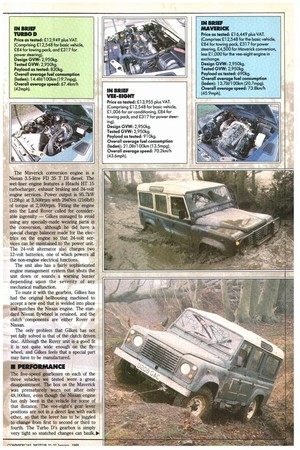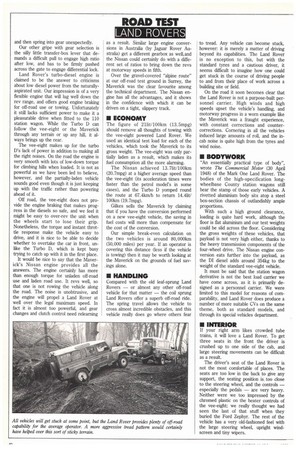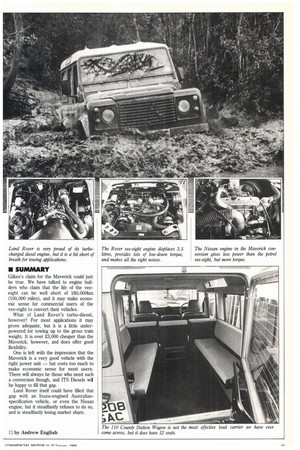THREE SIDES TO EVERY STORY
Page 40

Page 41

Page 42

Page 43

If you've noticed an error in this article please click here to report it so we can fix it.
Nissan diesel-engined "Maverick" Land Rover conversions are designed for operators in search of power. We put one up against the vee-eight and Turbo D Land Rovers to see how they compare.
le Land Rovers have been providing offroad mobility and extra towing capacity since 1948. Land Rover has become a generic name for cross-country vehicles, and still sets the standards by which other vehicles are judged.
Sadly, however, Land Rover sales have not been impressive in recent years. Third World sales have collapsed for all the big off-road vehicle manufacturers, but the state-owned UK company has failed to jump on the leisure market bandwagon in this country, and even its commercial vehicle sales have started to fall. In the mid-1970s Land Rover was producing nearly 60,000 vehicles per year. By 1987 production was down to just 19,000.
In the light commercial 4x4 market, Land Rover's sales fell by 3.8% in 1987. By contrast, Nissan and Mitsubishi sales rose by 57% and 2,100% respectively over the same period, although Land Rover does still hold 41.3% of the market.
One of the major problems for the Land Rover has been its perceived lack of power, particularly in diesel-engined form. Compared to the four-litre "six" of the Toyota Landcruiser or the three-litre Mercedes-Benz G-Wagen diesel, for instance, Land Rover's 2.5-litre "four" is seen as being too puny for a two-tonne wagon. Land Rover addressed the problem a few years back by introducing a turbocharged version of its little engine. Even that was not seen as enough — and the failure of the Perkins-developed "Iceberg" diesel conversion of Land Rover's 3.5-litre petrol vee-eight has left it without a more powerful alternative, at least until its rumoured "Gemini" direct-injection diesel arrives.
A sizeable cottage industry has built up to fit existing 4X4 vehicles with more "suitable" engines as a result of these perceived deficiencies in the standard Land Rover units.
To see just what difference such a conversion will make and, more importantly, to gauge whether or not it would be worthwhile, we arranged to test the ITS Nissan conversion against Land Rover's own two most powerful engines, the turbo-diesel four and the petrol vee-eight.
ITS MAVERICK
To make the comparison as accurate as possible, we tested each engine in the One-ten long-wheelbase station wagon. Frank Giles of ITS Diesels started by fitting the Fiat 80414 four-cylinder diesel engine to Land Rovers and Range Rovers. He then scoured the specification sheets of the world's engine marlufactirers for the best unit to use in the Land Rover and hit upon the Nissan FD range of direct-injection diesel engines.
Engineering drawings were requested, and in 1986 two Nissan engines were delivered to Gilkes's Moreton-in-Marsh workshop. Development work has continued apace since then, and many of the installa tion problems have been sorted out. ITS offers the Nissan engines in 3.3-litre and 3.5-litre form, with or without turbochargers. The largest engine, the FA 35 T, is the recommended replacement for the vee-eight petrol models with the fivespeed gearboxes.
Gilkes offers £1,000 for an unused carburettor version of the petrol vee-eight which can be discounted from the £4,500plus-VAT cost of the conversion.
• DRIVEUNES
All of our test vehicles share the Land Rover 4x4 system that has been standard since the introduction of the Land Rover 110 in 1983. Live coil sprung beam axles front and rear accept the propshaft drive from the centrally-mounted transfer box which gives permanent four-wheel drive, but has a switchable differential lock and the choice of a highor low-ratio set of drop gears.
The gearbox is the familiar five-speed Santana-built Land Rover unit with an overdrive fifth. Ratios differ between the Land Rover turbo-diesel and the vee-eight petrol boxes.
The 3.5-litre vee-eight petrol engine is the all-aluminium unit derived from the slightly larger 1960s Buick engine. It has a five-bearing crankshaft and hydraulic tappets, delivers 100kW (134hp) of power at 5, 00Orpm, and 253Nm (1871bft) of torque at 2,500rpm.
Land Rover's Turbo D engine is a turbocharged version of the 2.5-litre fourcylinder IDI diesel that was introduced at the Motor Show in 1986. Turbocharging has boosted the power to 64kW (85hp) at 4,000rpm, and the torque to 204Nm (150Ibft) at 1,800rpm.
The company has made a number of changes to the engine to suit the Garrett AiResearch T2 turbocharger: the crankshaft is cross-drilled to improve lubrication of the bearings, there are also nimonic exhaust valves and modified pistons and rings. The Maverick conversion engine is a Nissan 3.54itre FD 35 T DI diesel. The wet-liner engine features a Hitachi HT 15 turbocharger, exhaust braking and 24-volt engine services. Power output is 95.7kVer (129hp) at 3,500rpm with 294Nm (216Ibft) of torque at 2, 00Orprn. Fitting the engine into the Land Rover called for considerable ingenuity — Gilkes managed to avoid using any specially-made wearing parts in the conversion, although he did have a special charge balancer made for the electries on the engine so that 24-volt services can be maintained to the power unit. The 24-volt alternator also charges two 12-volt batteries, one of which powers all the non-engine electrical functions.
The unit also has a fairly sophisticated engine management system that shuts the unit down or sounds a warning buzzer depending upon the severity of any mechanical malfunction.
To mate it with the gearbox, Gilkes has had the original bellhousing machined to accept a new end that is welded into place and matches the Nissan engine. The standard Nissan flywheel is retained, and the clutch components are either Rover or Nissan.
The only problem that Gilkes has not yet fully solved is that of the clutch driven disc. Although the Rover unit is a good fit it is not quite wide enough on the flywheel, and Gilkes feels that a special part may have to be manufactured.
• PERFORMANCE
The five-speed gearboxes on each of the three vehicles we tested were a great disappointment. The box on the Maverick was prematurely worn out after only 48,000km, even though the Nissan engine has only been in the vehicle for some of that distance. The vee-eight's gear lever positions are not in a direct line with each other, so that the lever has to be juggled to change from first to second or third to fourth. The Turbo D's gearbox is simply very tight so snatched changes can baulk, and then spring into gear unexpectedly.
Our other gripe with gear selection is the silly little transfer-box lever that demands a difficult pull to engage high ratio after low, and has to be firmly pushed across the gate to engage differential lock.
Land Rover's turbo-diesel engine is claimed to be the answer to criticisms about low diesel power from the naturallyaspirated unit. Our impression is of a very flexible engine that will lug well down the rev range, and offers good engine braking for off-road use or towing. Unfortunately it still lacks sufficient power to make it a pleasurable drive when fitted to the 110 station wagon. While the Turbo D can follow the vee-eight or the Maverick through any terrain or up any hill, it always brings up the rear.
The vee-eight makes up for the turbo D's lack of power in addition to making all the right noises. On the road the engine is very smooth with lots of low-down torque for climbing hills when loaded. It is not as powerful as we have been led to believe, however, and the partially-laden vehicle sounds good even though it is just keeping up with the traffic rather than powering ahead of it.
Off road, the vee-eight does not provide the engine braking that makes progress in the diesels so safe, and we feel it might be easy to over-rev the unit when the wheels start to lose their grip. Nonetheless, the torque and instant throttle response make the vehicle easy to drive, and it is nice to be able to decide whether to overtake the car in front, unlike the Turbo D, which is kept busy trying to catch up with it in the first place.
It would be nice to say that the Maverick's Nissan engine provides all the answers. The engine certainly has more than enough torque for unladen off-road use and laden road use. It revs well, so that one is not rowing the vehicle along the road. The noise is unobtrusive, and the engine will propel a Land Rover at well over the legal maximum speed. In fact it is almost too powerful, and gear changes and clutch control need relearning as a result. Similar large engine conversions in Australia (by Jaguar Rover Australia) get a different gearbox as well, and the Nissan could certainly do with a different set of ratios to bring down the revs at motorway speeds in fifth.
Over the gravel-covered "alpine route" at our off-road test ground in Surrey, the Maverick was the clear favourite among the technical department. The Nissan engine has all the advantages, and it shows in the confidence with which it can be driven on a tight, slippery track.
• ECONOMY
The figure of 211it/100km (13.5mpg) should remove all thoughts of towing with the vee-eight powered Land Rover. We used an identical test load for each of the vehicles, which took the Maverick to its gross weight. The vee-eight was only partially laden as a result, which makes its fuel consumption all the more alarming.
The Nissan achieved 13.71it/100km (20.7mpg) at a higher average speed than the vee-eight (its acceleration times were faster than the petrol model's in some cases), and the Turbo D yomped round the route at 67.4km/h to return 14.41it/ 100km (19.7mpg).
Gilkes sells the Maverick by claiming that if you have the conversion performed on a new vee-eight vehicle, the saving in fuel costs will more than compensate for the cost of the conversion.
Our simple break-even calculation on the two vehicles is around 80,000km (50,000 miles) per year. If an operator is covering this distance (less if the vehicle is towing) then it may be worth looking at the Maverick on the grounds of fuel say.ings alone.
• HANDLING
Compared with the old leaf-sprung Land Rovers — or almost any other off-road vehicle for that matter — the coil sprung Land Rovers offer a superb off-road ride. The spring travel allows the vehicle to cross almost incredible obstacles, and this vehicle really does go where others fear to tread. Any vehicle can become stuck, however it is merely a matter of driving beyond its capabilities. The Land Rover is no exception to this, but with the standard tyres and a cautious driver, it seems difficult to imagine how one could get stuck in the course of driving people to and from their place of work across a building site or field.
On the road it soon becomes clear that the Land Rover is not a purpose-built personnel carrier. High winds and high speeds upset the vehicle's handling, and motorway progress in a worn example like the Maverick was a fraught experience, with constant corrections and countercorrections. Cornering in all the vehicles induced large amounts of roll, and the incab noise is quite high from the tyres and wind noise.
• BODYWORK
"An essentially practical type of body", wrote The Commercial Motor (30 April 1948) of the Mark One Land Rover. The bodies of the high-specification longwheelbase County station wagons still bear the stamp of those early vehicles. A rivetted aluminium body sits atop a steel box-section chassis of outlandishly ample proportions.
With such a high ground clearance, loading is quite hard work, although the floor is flat aluminium and our test weights could be slid across the floor. Considering the gross weights of these vehicles, that payload is not very high either, thanks to the heavy transmission components of the four-wheel drive. The Nissan engine conversion eats further into the payload, as the DI diesel adds around 354kg to the weight of the standard vee-eight vehicle.
It must be said that the station wagon derivative is not the best load carrier we have come across, as it is primarily designed as a personnel carrier. We were limited to this model for reasons of comparability, and Land Rover does produce a number of more suitable CVs on the same theme, both as standard models, and through its special vehicles department.
II INTERIOR
If your right arm likes crowded tube trains, it will love a Land Rover. To get three seats in the front the driver is crushed up to one side of the cab, and large steering movements can be difficult as a result.
The driver's seat of the Land Rover is not the most comfortable of places. The seats are too low in the back to give any support, the seating position is. too close to the steering wheel, and the controls — especially the pedals — are very heavy. Neither were we too impressed by the chromed plastic on the heater controls of the vee-eight; we really thought we had seen the last of that stuff when they buried the Ford Zephyr. The rest of the vehicle has a very old-fashioned feel with the large steering wheel, upright windscreen and tiny wipers.
• SUMMARY
Gilkes's claim for the Maverick could just be true. We have talked to engine builders who claim that the life of the veeeight can be well short of 160,400km (100,000 miles), and it may make economic sense for commercial users of the vee-eight to convert their vehicles.
What of Land Rover's turbo-diesel, however? For most applications it may prove adequate, but it is a little underpowered for towing up to the gross train weight. It is over £3,000 cheaper than the Maverick, however, and does offer good flexibility.
One is left with the impression that the Maverick is a very good vehicle with the right power unit — but costs too much to make economic sense for most users. There will always be those who need such a conversion though, and ITS Diesels wil be happy to fill that gap.
Land Rover itself could have filled that gap with an Isuzu-engined Australianspecification vehicle, or even the Nissan engine, but it steadfastly refuses to do so, and is steadfastly losing market share.
0 by Andrew English




















































































































